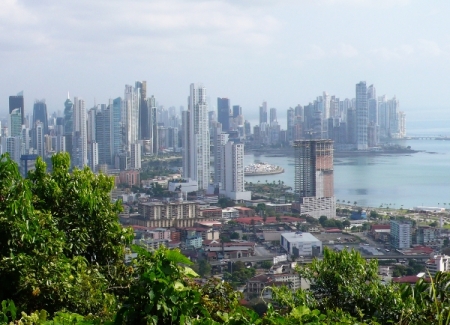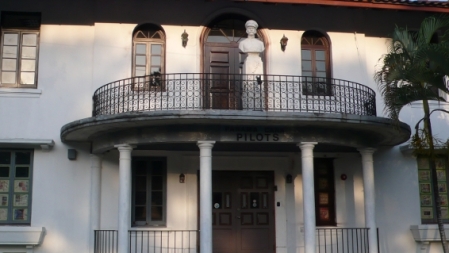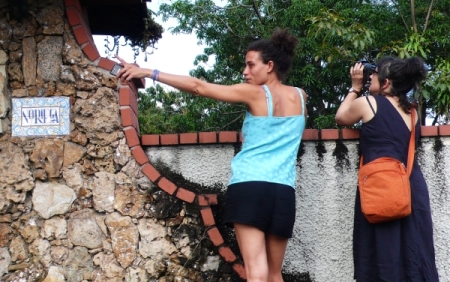A two-week residency in Panama
January 4: Claire Pentecost and I arrive in Panama City. We are greeted at the airport by Ela Spalding, the founder of Estudio Nuboso, who became interested in Claire’s work at Documenta 13 in Kassel, Germany. Ela has lived in Berlin for six years and is now returning to Panama to launch a series of residencies having to do with biodiversity and the prospects for a more ecological way of living. Claire’s work with soil fits beautifully into this program. My work on contemporary capitalist development and logistics – fits in perfectly, because this is Panama, the original Zone, the last piece of the western hemisphere to emerge from the seas and the first to crack under the pressure of free trade, which literally split the continent. We are going to learn a tremendous amount here about the ground beneath our feet…
I looked out the window and saw an elegant old building dedicated to Panama Canal pilots. The question: How to steer humanity’s course through these early decades of the twenty-first century? Obviously there are immense problems. As we drove around Panama City, looking at the remains of the US Canal Zone along with the sprawl of neoliberal urbanism – and trying, pretty successfully, to catch the joyful wild Panamanian spirit through all that – our conversation returned again and again to the events of the last fifteen years, since the US military moved out in the late 1990s and the widening of the Canal was voted by referendum in the early 2000s. Panama gained full independence only to witness a giant real-estate boom in both the city and the countryside, and a huge speculative infrastructure boom around the Canal. Here, as everywhere, there is a deficit of perception, reflection, expression and action to make a more egalitarian and more ecologically sustainable world. Artists and thinkers should be able to contribute something to overcome that deficit, no?
On the first day in town we went to the Canal Museum and began to understand how important the isthmus has been to world trade since 1515, when Balboa “discovered” what the indigenous people had always known: the Pacific Ocean. Later that night we ate dinner with a fascinating group gathered around Ela’s parents, Rafa and Charlotte, who have tremendous insights into the way this place has developed over the last five or six decades. Talk flowed freely as we met many of those who will gather next week for the Suelo residency at SaLo Veraguas, on the southern side of the Isthmus, about five hour’s drive from here. Out there we won’t have electricity or Internet, but maybe it will increase the power of eyes and hearts and eras. We’ve got a lot to learn from the past, though none of us can be proud of all of it. We’ve got even more to learn from the future.



January 12, 2014 at 11:42 pm |
Artists set the seen, speculators wipe it clean. Is that the sort of contribution artists can make? Like infrastructure builders, artists make a society more amenable, which is reflected in higher land prices. This is conveniently ignored by the corruption of economics, whereby neo-cons adjudicate the free lunch (delivered by the windfall gains of land) is only worth 2% of GDP. In Australia we have just calculated such unearned incomes at 23.6% of GDP.
If we are serious about a system that can finance the widening of canals whilst ensuring that beneficiaries pay their fair share (port owners and surrounding property owners), then more needs to be analysed of unearned incomes, the economic rents of the earth. Then speculative pariahs will not be able to swoop in so fast to move artists on in the gentrification process.
Have a read of the Total Resource Rents of Australia report.
I enjoy reading your blog, having found it via the Adam Curtis post…tho i fear what you would say of my doco, Real Estate 4 Ransom 😉
January 19, 2014 at 3:22 am |
Hello Karl, I´ll check out the film when I have a moment, suffice to say that the issue of land-grabbing is the biggest one discussed in our event here. The inhabitants of entire regions (particularly the coastal ones) are in effect held for ransom, losing the land they used to live on and work, having to become others´ servants, paying with the whole course of their lives. Much of the speculation that plagued English-speaking countries in particular, but also Spain and others, has shifted toward the developing countries in the wake of 2008. The question is how to stop that. I will write more on this…
January 20, 2014 at 12:10 am |
Brian – I’d love to read more on that! If you can come up with anything more effective than taxing land to remove the profiteering aspect I’d be very interested.
I agree that post GFC the mobility of capital has diversified investment portfolios into many nations. Here in the south, the Pacific is being snapped up for next to nothing, some of the last pristine environs are being carved up into subdivisions etc. Ecuador is also facing similar challenges from what a colleague says.
If you would like to discuss the topic on my Renegade Economists podcast, let me know.